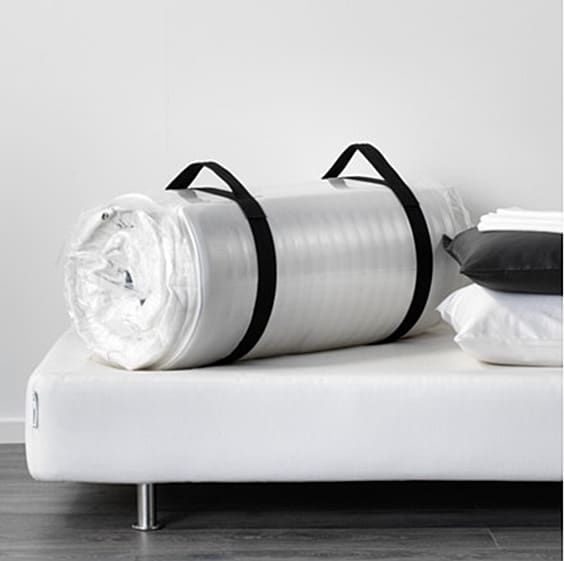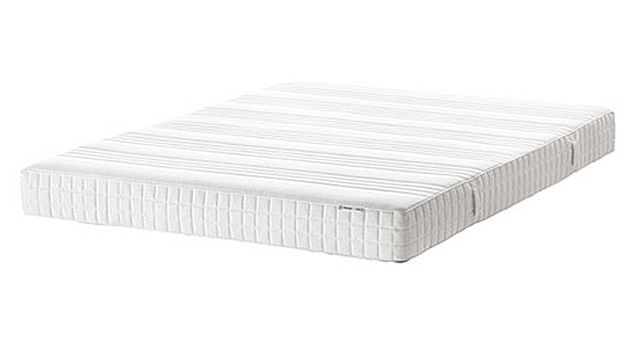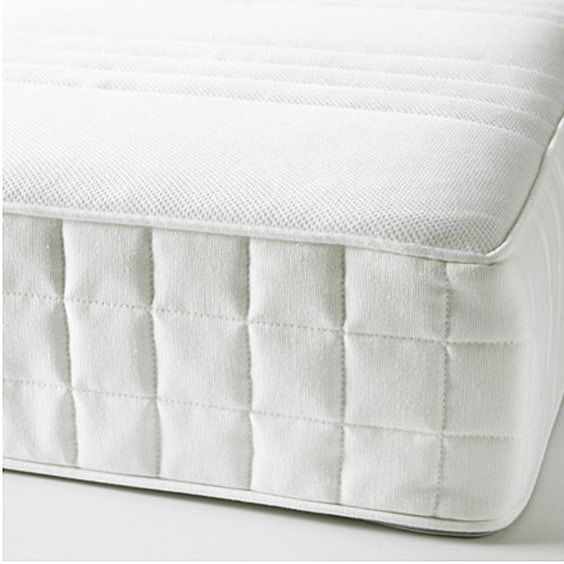When you’re on a budget, the best you can hope for is to get a mattress that is barely passable – i.e. you sleep on it and don’t feel the hard bed under it – but IKEA has set out to prove you can find better comfort and support than this without burning through your cash with their economical Matrand series, which is part of both their foam and latex lineups.
Read my Matrand mattress review to find out how it will perform, and decide if it is good enough for your bed.
Enter Matrand
Available in multiple core material and size variants, Matrand certainly does promise a great deal of choice to consumers who are tight on cash.
It incorporates latex and memory foam, which are both considered high end materials, and the support and comfort they offer is indeed superior to polyurethane foam, but they’re used rather sparingly here, which is why this mattress isn’t suited to heavy individuals.
This and other potential caveats will be addressed in detail, and I’ll try to keep things simple by discussing fundamental features of the latex and memory foam variants separately, so you can choose the better one between the two easily.
Pros
- Inexpensive.
- Provides a lot of choice for buyers on a budget.
- Uses relatively high end materials.
- Lasts longer than cheap polyfoam mattresses.
- Long term 25 year warranty.
- 365 exchange / refund policy.
Cons
- High end materials used sparingly.
- Synthetic latex may cause health problems.
- Latex model only available in Queen size.
- Won’t work for overweight (25+ BMI) individuals.
Features & Benefits
Core Materials
Latex
2” thick synthetic latex forms the comfort layer of Matrand latex variant. The comfort layer is cushioned by a 1.7 lb./cu.ft. dense polyfoam layer. While this combination does provide reasonable support for a normal weight person, it is plain that anyone with a BMI above 25 will find themselves sinking right through the relatively thin comfort layer – an altogether uncomfortable experience.
For those with a healthy BMI though – the medium-firm Dunlop process latex mattress will provide springy, responsive support for the muscles and joints, in contrast to the soft surface feel of memory foam. Here’s a video showing how to calculate BMI, if you don’t know. It is also worth noting that this version will offer superior heat dissipation as compared to memory foam.
Note that IKEA has used synthetic latex for this economy mattress line – scientifically, it is known as styrene butadiene rubber latex, and it has a wide range of applications from furniture and mattress foams to cement strengthening.
While it is a cheaper alternative to natural latex, it cannot match the latter in terms of support and durability. Furthermore, it contains chemicals that may contribute to the development of cancerous tumors.
Memory Foam
This variant utilizes a 2” thick layer of 3 lb./cu.ft. memory foam, which supports your body in an enveloping and personalized manner. The comfort layer is supported by a 1.7 lb./cu.ft. polyurethane foam layer just like the latex version.
The viscoelastic memory foam and regular poly foam combine to give this mattress a firm feel overall, while on the surface, you’re able to enjoy a sinking sensation each time you lie down on your bed. Thanks to the conforming nature of memory foam, normal weight individuals with back pain (or those seeking to prevent it) will find this mattress an economical solution.
The memory foam used is of the cheap variety with poor thermal ventilation, so if you find it hard to sleep in a hot bed, you may want to go with latex instead. Alternately, you could take a look at the slightly more expensive Myrbacka series from IKEA, which has a similar memory foam offering but with a natural wool / cotton cover to improve its heat dissipation.
Both latex and memory foam variants have standard non-woven polypropylene covers, and a comfort filling (over the comfort layer) composed of polyester and rayon.
Durability
The overall thickness of both memory foam and latex variants is 7 1/8” – which is somewhat stingy even by normal weight standards. Moreover, in both cases, the small thickness of the comfort layers and the use of relatively low density polyfoam as the base, means that you should be prepared to see some deformation after a few years of regular use.
That said, the latex version may last a bit longer than the memory foam one – since latex is an intrinsically sturdy core material, whereas low density memory foam (as used in Matrand) has been known to rapidly deteriorate.
To get the most out of these mattresses use them for a kids’ bedroom – or for a guest room where they see only a few weeks of use at best, and have ample time to regain their shapes.
Convenience & Maintenance
All Matrand mattresses are delivered roll-packed, so you can easily transport them to your home from the drop off point in your own car. Keep in mind though, that roll-packed mattresses may take around a day to regain their original shape and size.
These mattresses have removable covers, which should facilitate you in keeping them tidy for a long time.
365 Refund / Exchange Policy
Surprising for a product this cheap, IKEA offers a straightforward refund policy that holds for 365 days from the date of purchase. If you’re unhappy with how the mattress performs, and have not exposed it to physical abuse, you can get a full refund.
Alternately, you could get the mattress exchanged for another identical model, but this is a one-time deal.
25 Year Limited Warranty
Matrand mattresses, like every other mattress from IKEA, come with a 25 year warranty that protects against defects in craftsmanship and materials. Bear in mind that you’ll need a receipt of purchase, along with a valid photo ID, to avail both the warranty and the refund/exchange policy.
What do other users have to say?
Scouring through the consumer feedback for this mattress, it looks pretty much as expected: the mattress is able to provide decent pressure relief and support, but starts sagging after some months if used by even slightly bulky individuals. This should reinforce my recommendation that it is only intended for regular use by individuals with a BMI below 25.
This series has received praise in particular for its suitability for children’s bedrooms, where it can be used for a period that may be considered long term, but some people have found the memory foam variant to be a bit too much on the firm side.
Conclusion
Having reached the end of my IKEA Matrand review, based on the discussion of features (i.e. core materials, thickness, density) and the summary of user feedback, it should be clear to you that this isn’t a high end solution – nor does it claim to be. What it does is provide you decidedly better support and comfort than a run-of-the-mill polyfoam mattress, at only a slightly more expensive price point.
This makes the mattress suitable for the mainstream who normally find it hard to save up and splurge on a true high end latex / memory foam solution, in particular, those who suffer from back pain on regular foam.
Using a Matrand mattress within the normal BMI range should see it last you for a good amount of time (though possibly not as long as pricier offerings). Even so, combined with its generous refund and warranty policies, this makes it a very fair bargain.
Frequently Asked Questions
Is a Foundation Needed?
Recommended for best durability expectations.
Is a Mattress Pad or Protector Needed?
Recommended for best durability expectations.
Are returns hassle free?
Yes, with the first 365 days of ownership.
Does it Work on Adjustable Beds?
Yes.
Is There A Trial Available?
365 nights.
How long is the warranty?
25 years.
Does It Need To Be Rotated?
No.



